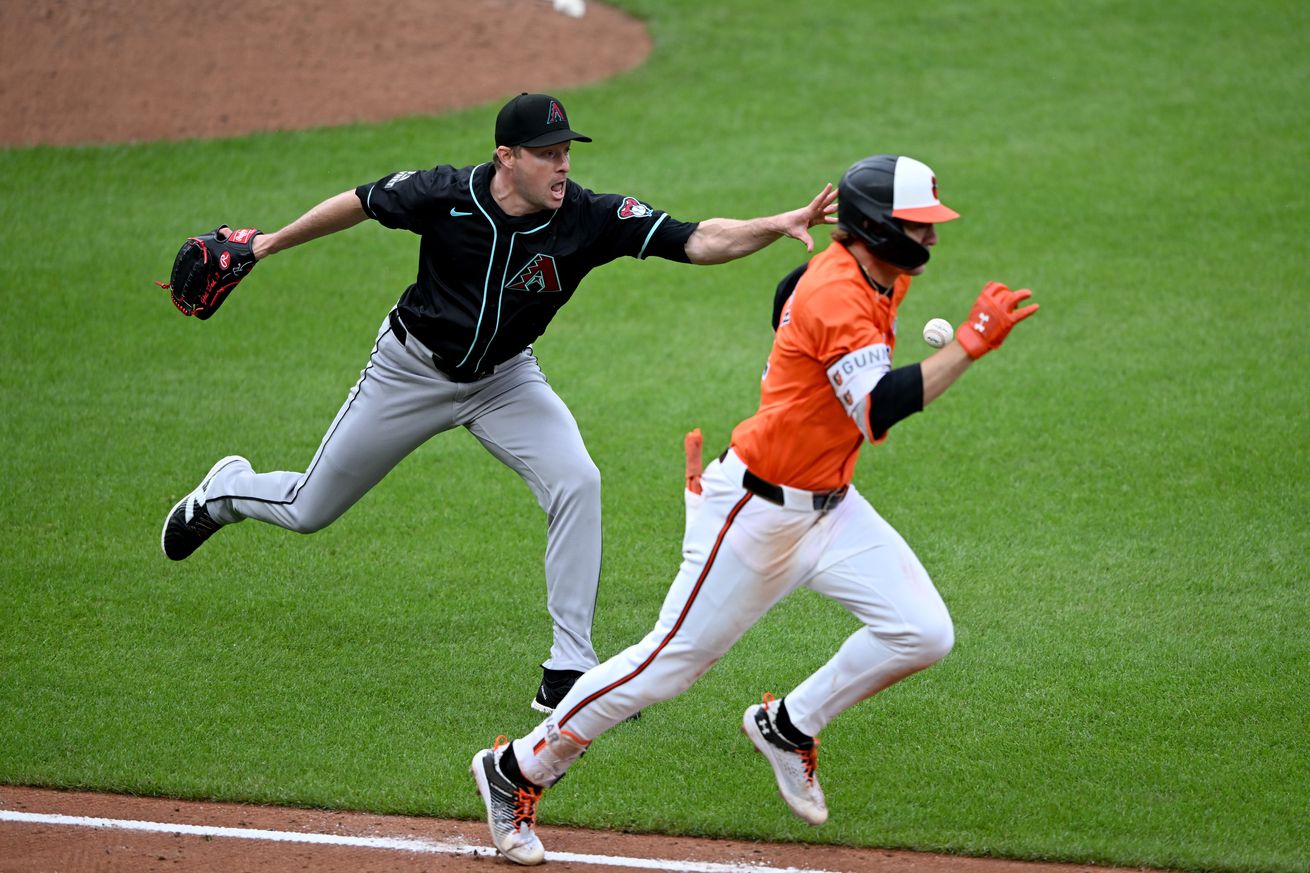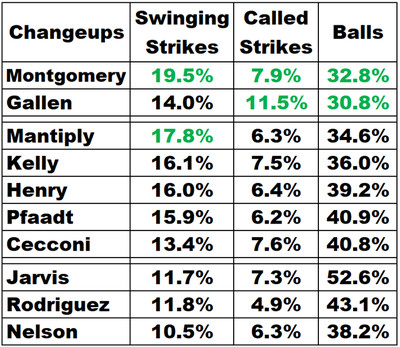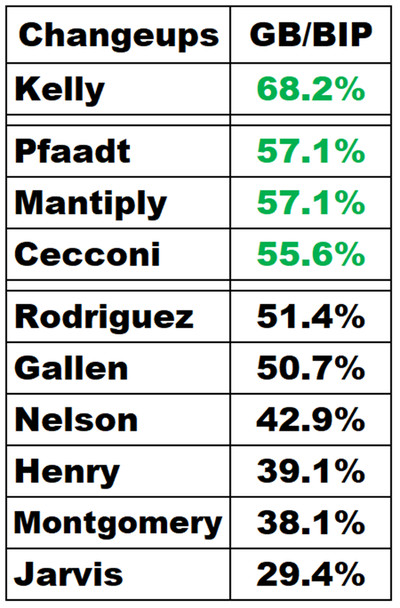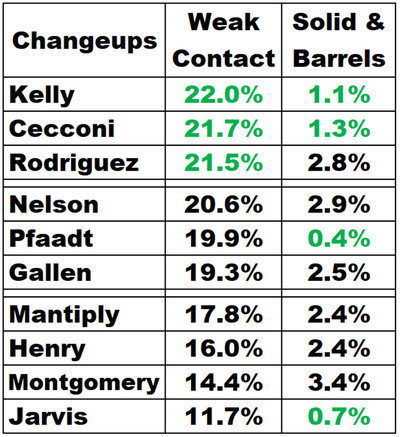
It depends on what you look at.
Who had the highest percentage of changeups?
Of the ten Diamondbacks pitchers who pitched at least 100 changeups this season, who had the highest percentage of changeups? Mantiply and Rodriguez were highest with 26.5% and 23.7%. The next most were Kelly, Montgomery, and Henry. Interestingly, four of these five pitchers are thought of as starting pitchers.
As discussed in this AZ Snake Pit roundtable, Cecconi stopped pitching changeups after 5 July. My view is that because of a few batters who had success that day, Cecconi was no longer comfortable and confident with his changeups. That is a fixable situation. My view is that perhaps the pitchers with the highest percentages are comfortable and confident with their changeups.
Who had the most effective changeups?
Let’s look at called strikes and balls, ground balls, and quality of contact.
Swing and Miss. For many pitchers, changeups are intended to encourage batters to swing and miss. Also, on the next pitches the batter may hesitate to swing at fastballs. Two pitchers stood out with the highest percentages of changeup whiffs (Montgomery with 18.4%, and Mantiply with 15.9%).
Saturday, in the seventh inning against the Brewers, Mantiply struck out all three batters. Willy Adames’ second strike was a whiff on a changeup, Jackson Chourio’s third strike was a whiff on a changeup, and Rhys Hoskins second strike was a foul ball against a changeup.
Looking at all pitchers in the Majors, 15.5% of changeups were swings and misses compared to only 11.7% for all other pitches. These ten Diamondbacks averaged 14.0% of changeups were swings and misses. But there are other reasons for changeups.
Called Strikes and Balls. Some pitchers are fine with batters not swinging because their changeups cross the plate near the strike zone. Two pitchers stood out as having the highest percentages of changeup called strikes (Montgomery with 7.9% and Gallen with 11.5%). These same two pitchers had the lowest percentages of changeup balls (Montgomery with 32.8% and Gallen with 30.8%.
It may be surprising that 40% to 60% of changeups were not swung at. Does that mean that batters were only fooled about half the time?
The following table shows swinging strikes, balls, and called strikes (no swings) when pitches are changeups.

2024 Season through 14 September. Data from Baseball Savant.
Ground Balls. In 2020, Kyle Freeland had a different primary benefit from changeups. That benefit was weak contact per this SB Nation article. That season, only 10.0% of his changeups were swings and misses. His benefit was 55.7% of changeup balls in play (FBs, LDs, GBs, & PUs) were ground balls.
https://www.purplerow.com/2021/3/25/22349550/colorado-rockies-news-the-mystery-of-kyle-freelands-changeup-devin-williams-ryu-hendricks-davies
Kelly is way out in front with 68.2% ground balls in his changeups that become balls in play. Also high were Pfaadt, Mantiply and Cecconi.
The percentage of changeup balls-in-play that are ground balls are shown in the following table.

2024 Season through 14 September. Data from Baseball Savant.
Weak Contact. Some pitchers benefit from weak contact instead of solid contact and barrels. Kelly, Cecconi and Rodriguez have changeup weak contact percentages that are the best on the Diamondbacks.
The percentages of changeups pitched that results in weak contact balls in play are shown in the following table:

2024 Season through 14 September. Data from Baseball Savant.
Did changeups enhance the effectiveness of fastballs?
“I think sometimes we kind of get ourselves into a hole, with we are only using fastball, slider. So, working in the changeup and curveball are crucial. I think it’s a game changer. Luckily, we had a little bit of everything going yesterday.” — Brandon Pfaadt, in-game interview by Jody Jackson, 20 September
To definitively answer this question would be long and complex. Instead let’s look at a high level.
I’m fairly sure that the difference in velocity (between changeup and fastball) is important. But that unsight did not answer the question.
Another insight is that it’s likely that the impact is different for 2-seam and 4-seam fastballs.
Of the ten Diamondbacks who pitch changeups, three of them predominently pitch 4-seam fastballs, one of them predominently pitches 2-seam fastballs, and the other six of them pitch a significant number of 1-seam and 2-seam fastballs (per Baseball Savant). I did not expect that most of them pitched both types of fastballs. This extra complexity left me looking for a different approach.
Let’s look at the four pitchers who pitched the highest percentage of changups. I made an assumption: If their changeups positively impacted their fastballs, then their fastball results should be favorable (below average OBP and SLG). My conclusions follow:
- Three of the four pitchers had below average OBP for 4-seam fastballs. The fourth was near average. It’s possible that changups favorably impacted OBP for 4-seam fastballs.
- Only Joe Mantiply had below average OBP and SLG for 2-seam fastballs. Except for him, I found no reason to think that changeups favorably impacted 2-seam fastballs.
Details are shown in the following table.

2024 Season through 14 September. Data from Baseball Savant.
Future questions remain.
Worthy of future investigation is this question: Which benefit predominates, and does it depend on these three things?
- Each pitcher’s other types of pitches.
- Pitch sequencing.
- Where the changeup typically crosses the plate.
Summary.
Being comfortable and confident matters when pitching changeups. Mantiply and Rodriguez had the highest percentage of changeups, so it’s likely they are comfortable and confident throwing changeups.
The predominant benefit of changeups varied by pitcher.
- Mantiply and Montgomery had the highest percentage of swinging strikes.
- Montgomery and Gallen had the highest percentages of called strikes and lowest percentags of called balls.
- Kelly’s percentage of ground balls to balls-in-play was the highest. Almost as high were Mantiply, Pfaadt, and Cecconi.
- Kelly, Cecconi, and Rodriguez had the highest percentage of weak contact.
It’s possible that changups favorably impacted (lowered On-Base-Percentage) for 4-seam fastballs.
Except for Mantiply, I found no reason to think that changeups favorably impacted 2-seam fastballs.
